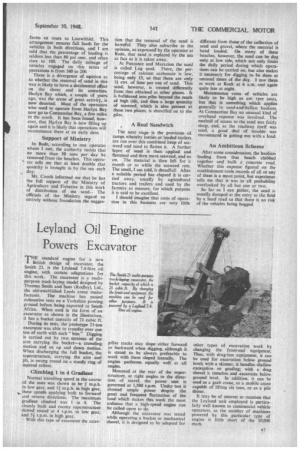Leyland Oil Engine Powers Excavator
Page 41

If you've noticed an error in this article please click here to report it so we can fix it.
THE standard engine for a new British design of excavator, the Smith 21, is the Leyland 7.4-litre oil engine, with certain adaptations for this work. The excavator is a multipurpose track-laying model designed by Thomas Smith and Suns (Rodley), Ltd., the old-established Leeds crane manufacturer. The machine has passed exhaustive tests on a Yorkshire proving ground before being exported to South Africa. When used in the form of an excavator as shown in the illustration, it has a bucket capacity of 21 cubic ft.
During its tests, the prototype 21-ton excavator was able to transfer over one ton of earth with each "bite." Digging is carried out by two motions of the arm carrying the bucket—a crowding motion and an up and down motion. When discharging the full bucket, the superstructure. carrying the arm and jib, is swung round on a sturdy ring of tapered rollers.
Climbing 1 in 4 Gradient Normal travelling speed in the course of the tests was shown to be m.p.h. in low gear, and lf m.p.h. in high gear, these speeds applying both to forward and reverse directions. The maximum gradient climbed was 1 in 4. The cleanly built and roomy superstructure stewed round at 4 r.p.m. in low gear, and 51 r.p.m. in high gear.
With this type of excavator the cater
pillar tracks may slope either forward or backward when digging, although it is stated to be always preferable to work with them sloped laterally. The engine performs equally well at all angles.
Mounted at the rear of the superstructure, at right angles to the direction of travel, the power unit is governed at 1.500 r.p.m. Under test it showed ample power despite the great and frequent fluctuation of the load which makes this work the most arduous that a high-speed engine can be called upon to do.
Although the excavator was tested while operating a bucket or mechanical shovel, it is designed to be adapted for other types of excavation work by changing the front-end equipment. Thus, with drag-line equipment, it can be used for excavation below ground level; with a skinner, it handles shallow excavation or grading; with a drag shovel it trenches and excavates below ground level. In addition, it can be used as a grab crane, as a mobile crane capable of lifting six tons, or as a pile driver.
It may be of interest to mention that the Leyland unit employed is particularly well known to commercial vehicle operators, as the number of machines powered by this particular type of engine is little short of the 10,000 mark.




















































































